Review of the smartphone Meizu MX3
Welcome, Habraludi! Finally, the sales of our flagship device Meizu MX3 have started and today we are pleased to present you a detailed overview of this smartphone. We will understand the pros, cons, as well as all the features of the Meizu MX3.

')
The box is traditionally white in color, neatly made, the material is thick cardboard. On the front side is the “MX3” model. On the back of the following parameters: the weight of the device, the amount of memory, equipment and communication capabilities.


Inside the box you will find an original “book” with brief information about the device, a user manual, a small package with a USB cable and a plastic “clip” for opening the lid, a network adapter for the Russian standard. In general, the packaging is not much different from that for the Meizu MX2.
Despite the similarities between the MX2 and MX3, the latter is still different from the flagship of the previous year. The first thing worth noting is the dimensions: in the last year's model, the thickness was 10.2 mm, while the novelty has 9.1 mm. It seems to be a small difference, but in the Meizu MX3, the side faces are beveled more strongly, so the impression is created (and the sensations, too) that the gadget is much thinner than the MX2. Just because of this, the smartphone is ideally in the hand. Another question is the increased size of the case (139x71x9.1mm versus 124x64x10.2), but there's nothing you can do, since the screen diagonal also increased from 4.4 to 5.1 inches.
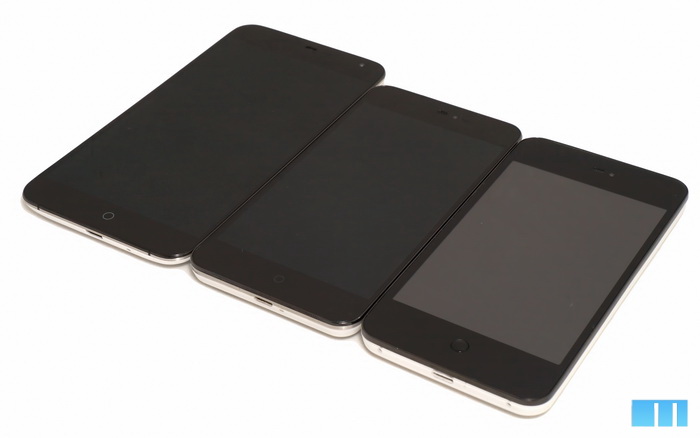
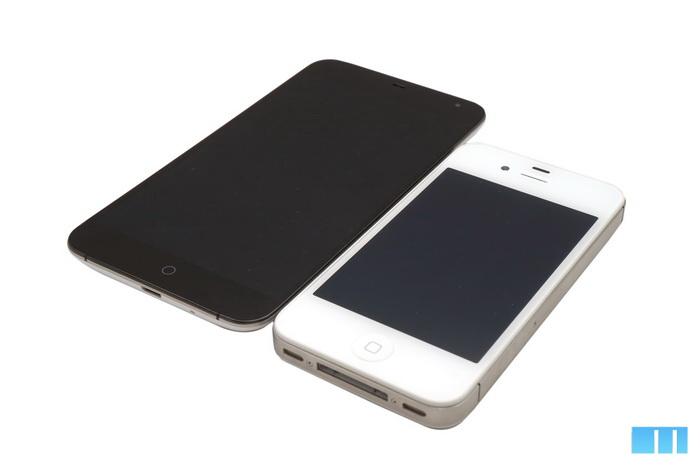
Became thinner display frame. Now, to the right and to the left, they are only 2.9 mm, and from above and below - 14 mm. Looks very elegant. Since the front panel is black, in the off state of the screen the frames are not at all visible (if we are talking about a black smartphone) - one dark plane without any fancy elements.

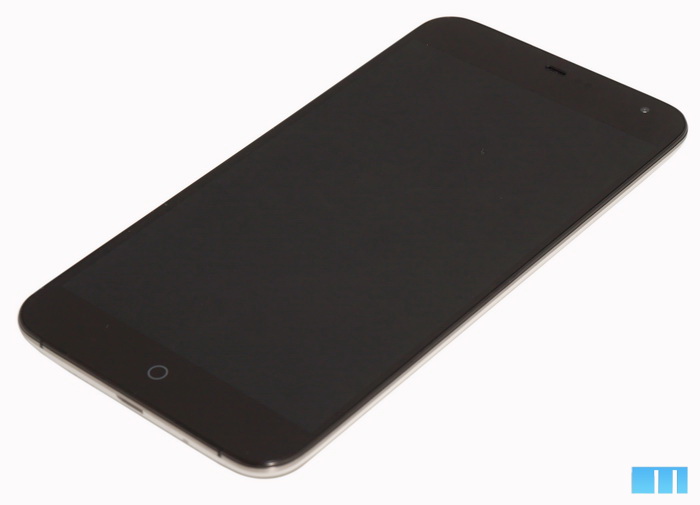
The case is made in such a way that the side frame (by the way, it has become almost two times thinner than in MX2) almost does not heat up when the processor is under heavy load, since this is not a single metal plate, but a design with several elements. Vertical polishing is applied to the piping, this further emphasizes the "hardware" used in the manufacture of the phone.
Screenshots from the official website of Meizu:
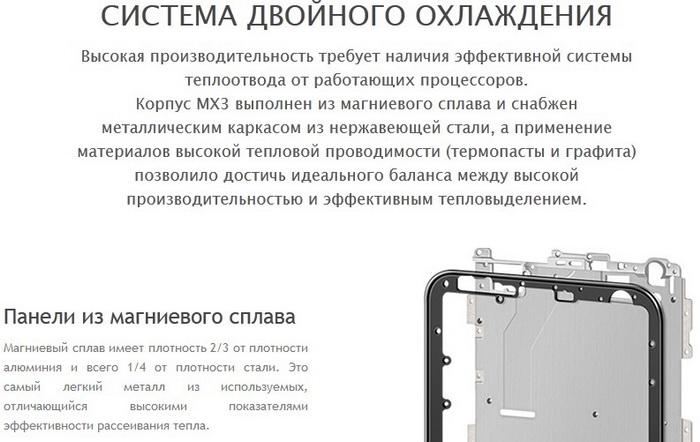


The back panel is still removable, but under it you will find only a slot for a microSIM card and a battery. The lid is plastic, white (if you remember, in MX2 it is closer to the milk one), the surface is glossy. Unlike the Meizu MX2, here the lid does not have a “glazed” effect: the bottom layer is opaque, the top is glossy. Over time, small scratches will appear on the panel, just like on any other device that uses plastic. However, it is not scary - if the cover is worn out, you can always buy a new one of the same or a different color. The prints on the cover of course remain, but almost not noticeable. The screen has an oleophobic coating and traces of it are erased very easily.


If we talk about the assembly, it is perfect. Even strongly “used” non-commercial samples almost did not play or creaked. With commercial devices, everything is all the more good: there are no gaps, cracks or other defects, the lid is very securely fastened, and even if the smartphone falls, it most likely will not fly off.
On the front side of the smartphone at the top is a small slot where the speaker is located. Voice quality is excellent, the volume is high, there is no noise, no echo. They hear you too well: for several weeks no communication breaks, “croaking” and signal disappearing for short periods of time were noticed.

Just to the right of the speaker are two special sensors for tracking ambient light and locking the screen while holding the phone to your ear. Work properly. More to the right - an additional camera for video chats.
At the bottom is a small round touch button. Unlike the previous MX2, in MX3 it is more noticeable; if you want, it is highlighted more brightly. It performs, in principle, the same functions, but the gestures have slightly changed. For example, to unlock a smartphone, you need to slide your finger from the “roundel” to the screen, after unlocking in this way, you immediately get to the screen with program shortcuts, and not to the lock screen, as it was on MX2. In my opinion, very simple and fast. “Swipe” up - the action “back”, long holding the touch ring - lock the screen. In the active state, the button is lit in white, while skipping messages or other events flashes intermittently, and in standby mode it turns dim in dark green.
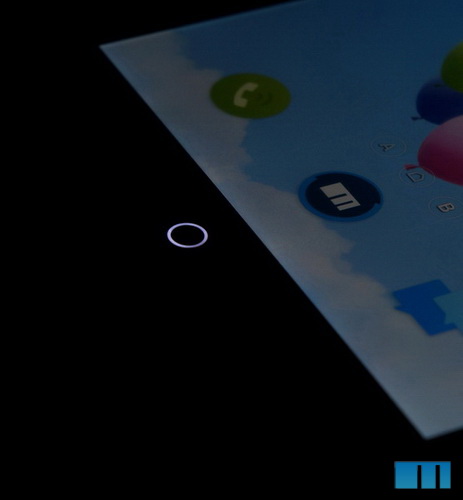
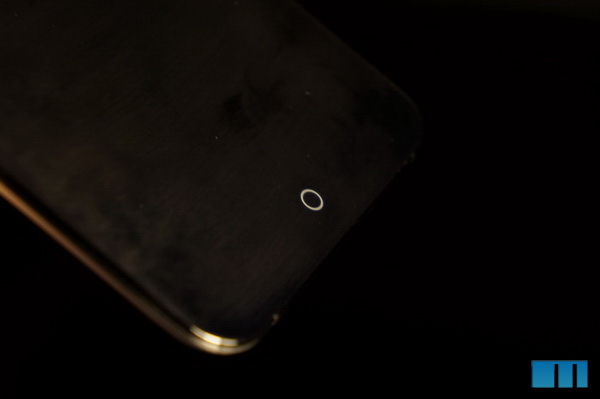
The volume key is located on the left side of the smartphone. Made from translucent white plastic. It is thin, but easily groped with fingers.
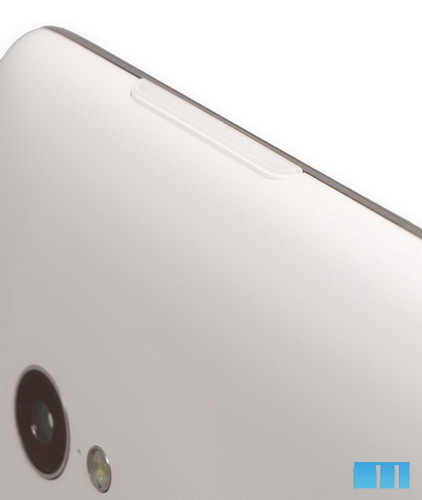
The microUSB connector is located on the bottom, next to the main microphone. Above - the usual 3.5 mm audio jack and power on / off button, as well as the screen lock / unlock.
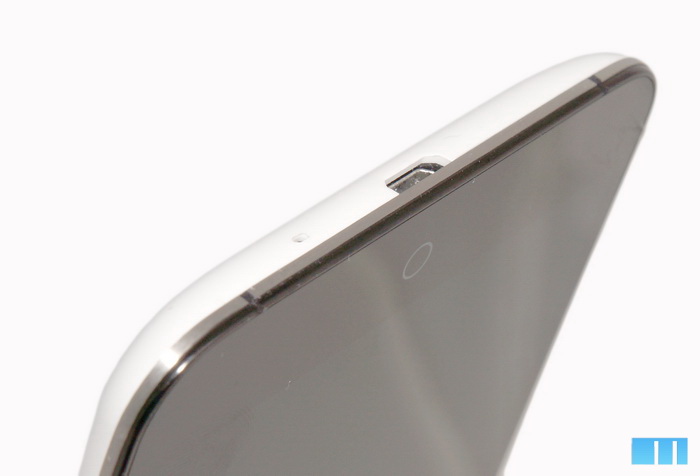

Behind are the camera's peephole, covered with protective glass and framed with a metal frame, a small flash, a second microphone and a speaker. The speaker volume is quite high, standard ringtones are well chosen - many of them can be heard, even if you close the speaker hole.

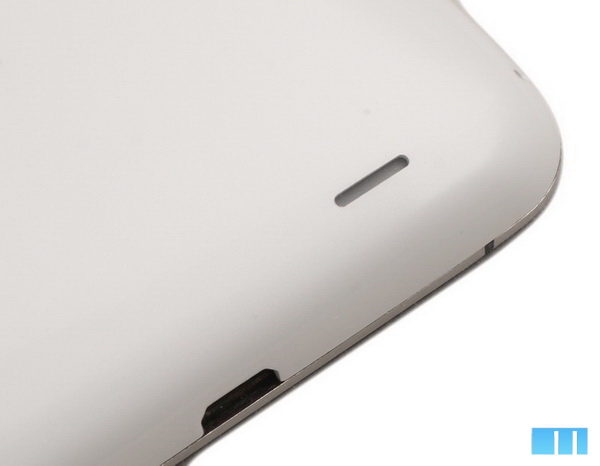
To remove the cover Meizu MX3, you need a special tool, "mediator", included in the kit. Insert it into the hole located on the right lower edge of the smartphone, and gently pull the cover with your nails. From the first time, not everyone gets it, but if you do it without haste, there will be no problems.
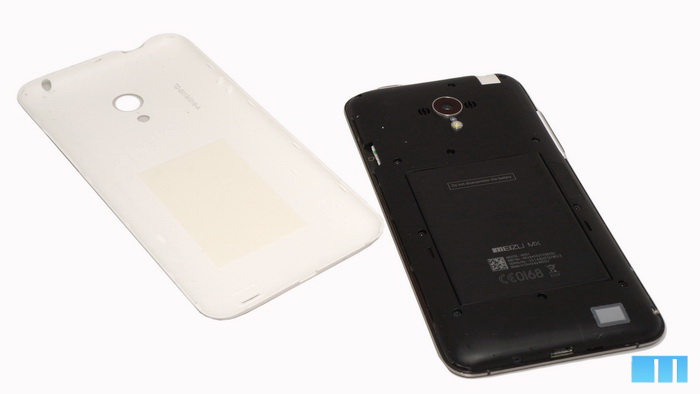

In the first MX, the screen diagonal was 4 inches, in the second - 4.4, and in the third the screen “grew” to 5.1 inches. The resolution also became more and more: 540x960, 800x1280, in the new product it is 1080x1800 pixels. The density in pixels is 415 (pixels on the display, even with good will, you will not see, unless, of course, you resort to a magnifying glass or microscope), according to the measured manufacturer’s data, the contrast is 1000: 1, the maximum brightness is 450 cd / m, gray gradations are 2048. Matrix display Meizu MX3 (as well as the MX2) is made by technology Sharp New Mode 2 - analog Sharp IGZO. When compared to IPS-LCD, then the MX3 matrix has more viewing angles, and the colors are not distorted under any inclination of the screen. It gives pleasant juicy colors, let's say, almost natural. There is no air gap between the matrix and the protective glass of Gorilla Glass 2 - TOL technology. In addition, developers are talking about energy-saving technology PRS - (PanelSelf-Refresh), it allows you to spend less energy to display data on the screen.
The touch layer is made by capacitive technology and handles up to 10 simultaneous touches. Brightness has a very large control range. The minimum brightness is sufficient for comfortable reading of books at night, and on a sunny day it can be done higher, well, or trust the automation. In the sun, the screen remains well read.
Settings:


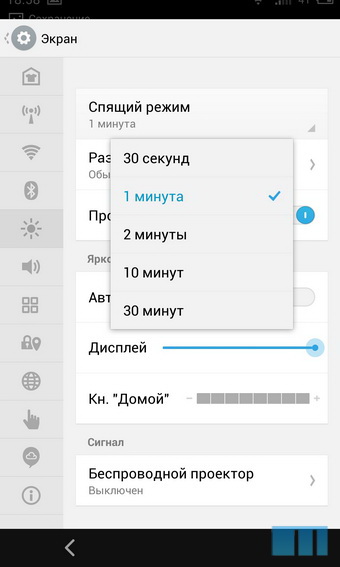
Screen:

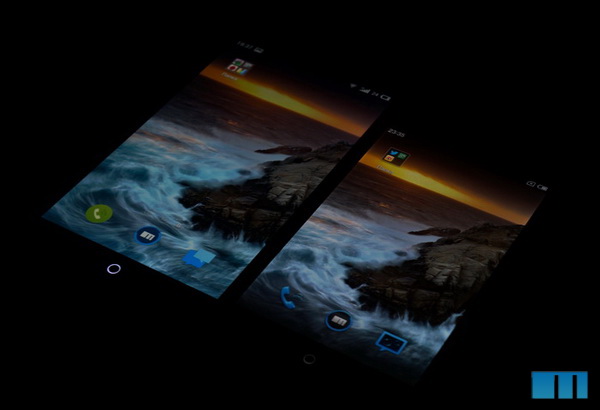

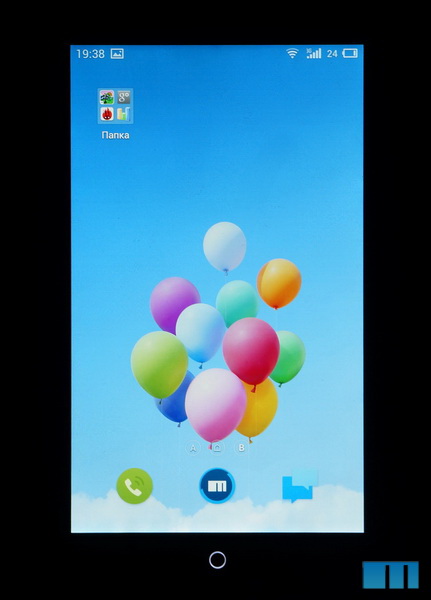
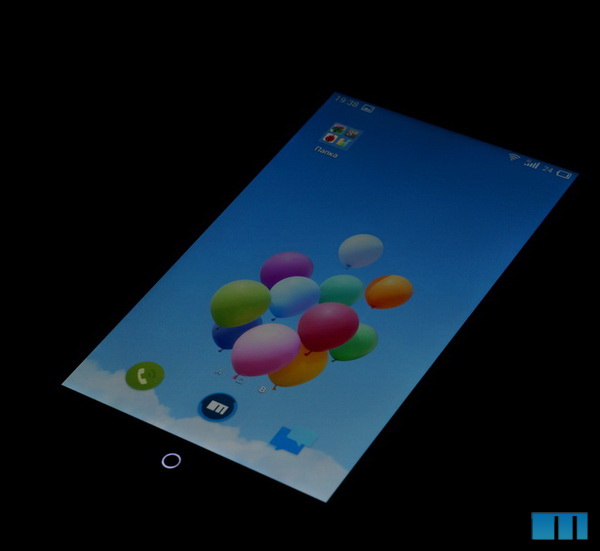
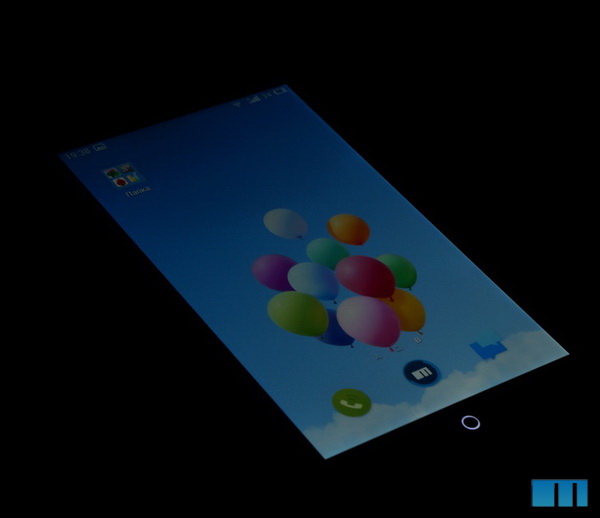
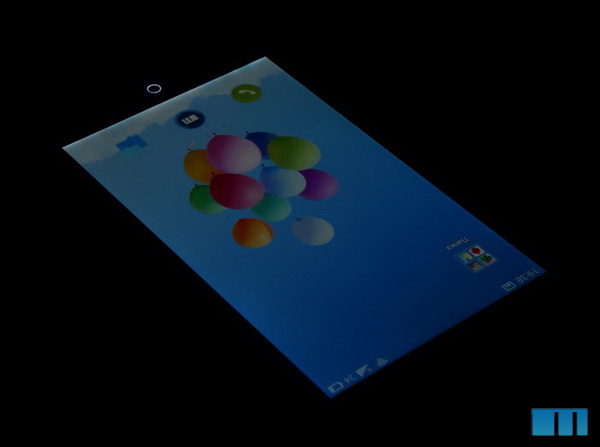
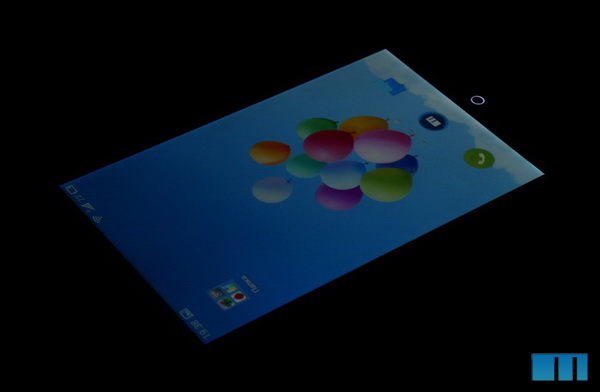
The Meizu MX3 uses one of the newest platforms from Samsung - the Exynos 5410: an 8-core processor (4-core 1.6 GHz Cortex-A15 and 4-core 1.2 GHz Cortex-A7), 28-nm LP process HKMG. The architecture of the Cortex-A15 and the modern 28nm LP LP HKMG technological process increase the computational power of the model by 1.8 times compared with the previous generation.
The graphic part is a PowerVR SGX544 MP3 chip (533MHz, 3-cores), it renders at a speed of 280 million triangles per second and can effectively fill 7.9 billion pixels, which is equivalent to updating the high-resolution screen 1270 times per second. The performance of the new GPU has increased by 267% compared with the previous generation.
RAM in the device 2 GB (dual-channel third-generation DDR3). This allowed us to provide data throughput at speeds of up to 12.8 GB / s. Free from this volume is about 1.2 GB.
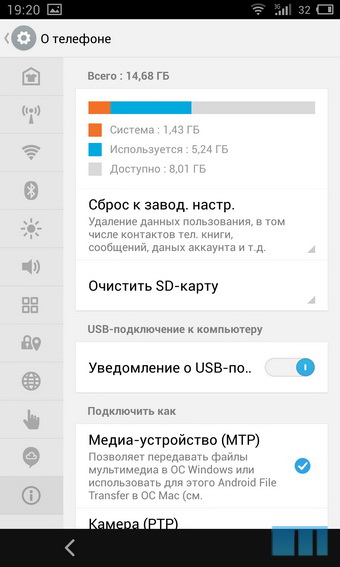
Built-in memory 16/32/64 GB. The 128 GB model was originally planned, including in the international version, but so far the company does not provide information on when it will appear. The system and the basic applications employ about 3 GB, that is, in 16 GB models, approximately 13 GB are free, in 32 - 29 GB, and so on.

The following are the most popular synthetic system performance tests:




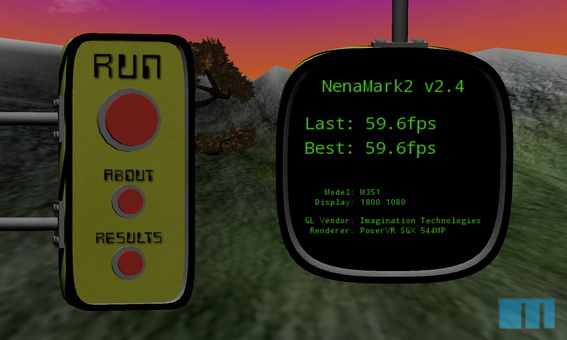
As with any Android smartphone, there is a Google Maps application for GPS or GLONASS navigation. Testing in the GPS test program showed that a cold start takes about 2 minutes, and a hot start takes just less than 7-10 seconds. If you turn on A-GPS and mobile Internet, the wait can be reduced to 5 seconds.
Meizu MX3 works in networks GSM / GPRS / EDGE / 3G (WCDMA) / HSPA + 850/900/1800 MHz (2G), 850/2100 MHz (3G), there is support for Wi-Fi 802.11 b / g / n, 2.4GHz / 5GHz (max speed 150 Mbit / s) and Bluetooth version 4.0. In place of USB 2.0, to which you can connect, for example, a data storage device (USB flash drive), since the phone supports USB Host. In models with 32 GB of memory and above, there is an NFC chip.



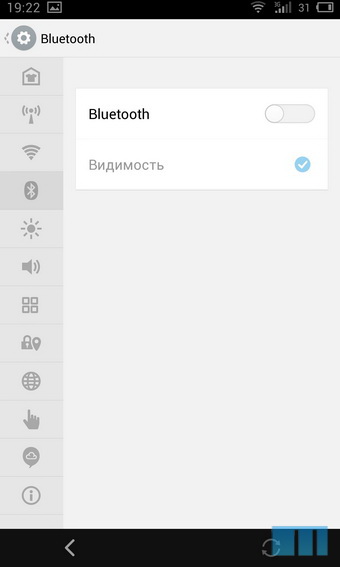
For more convenient switching of network modes, Flyme has built-in switches, they are located at the top right in the "notification panel".
Despite the general trend of expanding megapixels in the cameras of mobile devices, Meizu did not, roughly speaking, show off, so in the MX3 model we have an 8 megapixel main camera module and 2 megapixels frontal. However, the main camera sensor is a Sony Exmor BSI module (IMX179 CMOS chip, 1.4μm photosensitive element), and the aperture is F2.0!

The quality of the photos is not bad, but the developers still have to work on the camera, since there is still a lot of noise. This should not worry the users, since the situation was about the same with MX2 immediately after the launch: after a small amount of time, the firmware was introduced, which “fixed” all the “bugs” of the camera (sorry for the slang). If we talk about the pros, it is worth highlighting the excellent white balance, fast autofocus, zero delay, high shooting speed (up to 20 fps) and super macro from 2 cm. Rollers MX3 writes in FullHD resolution 30 fps, autofocus is induced when touched screen.
Photo mode :
To display the HDR settings and exposure, click on the screen twice.







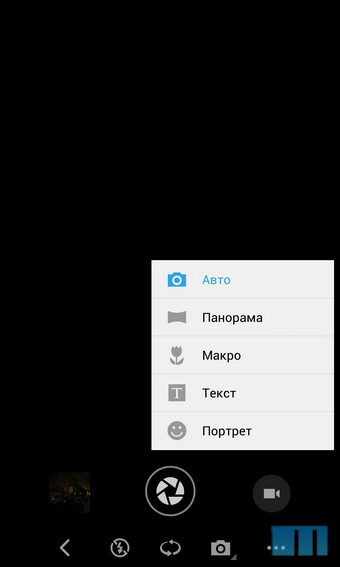
Gallery:
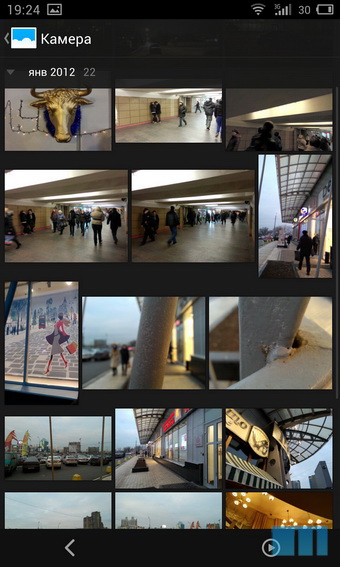

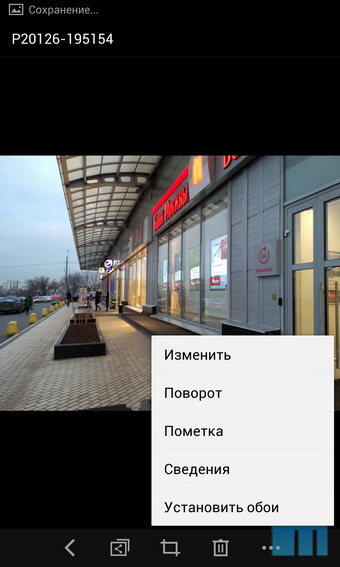
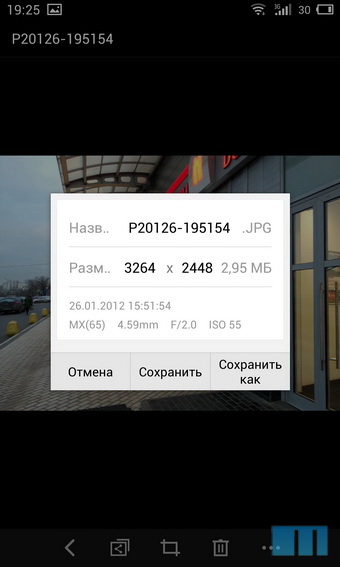


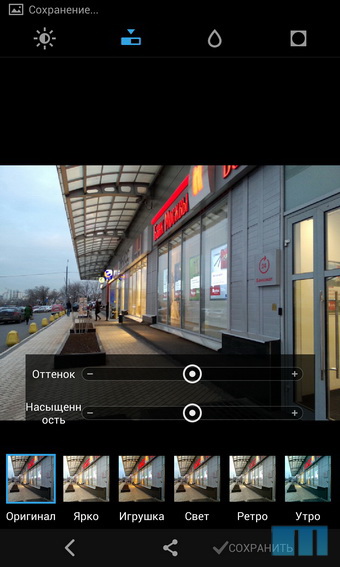

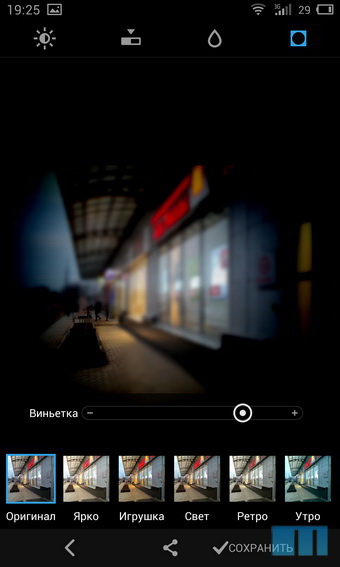
Below are examples of photos:



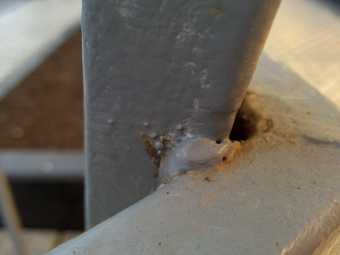




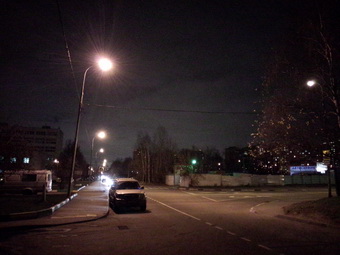
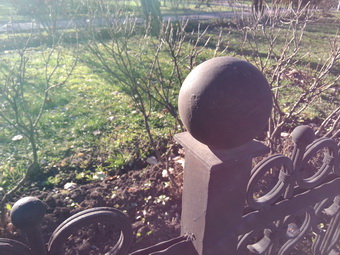




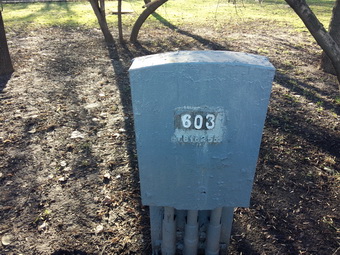










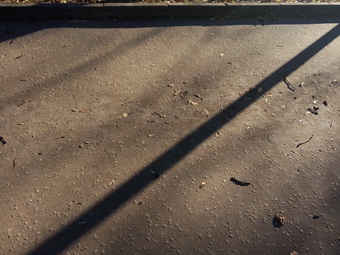

Front-camera:

The device was equipped with a built-in lithium-ion (Li-Ion) battery, the capacity of which is 2400 mAh. Model - Sony M351. After thorough testing, I cite a little more correct data. In parentheses indicate official data.
By default, the battery statistics in Flyme 3 is hidden in the Meizu MX3 settings. In order for it to appear, you need to enter * # * # 6961 # * # * in the "dialer" of the phone (after entering the code, go to Settings - Accessibility - Battery).



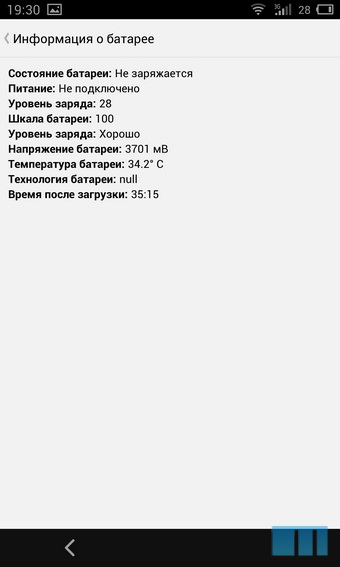
To get additional information about the device (battery status, heat, usage statistics, information about Wi-Fi and the phone itself), you need to enter the combination * # * # 4636 # * # * in the dialer.
Meizu MX3 works on the Android 4.2.1 Jelly Bean operating system with the proprietary UI Flyme 3 (latest update at the time of the review). In the coming days we will prepare a detailed overview of the shell, so in this text I will focus only on the main points.
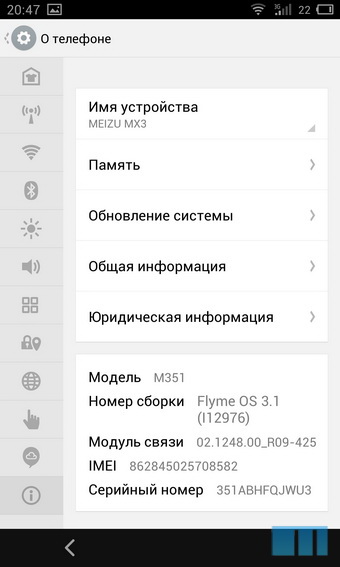
Icons . They have become flatter, but for those who love volume and color, there are alternative themes with colorful icons.


Settings . Now, having entered the settings, you can see the icons on the left, and the parameters that correspond to the section on the right. “Swipe” to the left to the right of the icon opens the description of the section.


Animation . It became smoother, noticeably, as when launching applications it flies out from the center of the screen and flies away to the center when it leaves it.
List of applications . Now labels can be ordered not only on separate desktops on the right or on the left, but also to place icons under the main desktops. To do this, drag any icon under the lowest icon.

Panel with running programs . It is necessary to hold your finger from the bottom edge of the screen up. To unload all applications from the device’s memory, “swipe” to the icon down, to close a specific “program” - “swipe” up. If you run your finger along the panel from right to left, a brightness control scale will appear and slots for assigning quick launch applications (up to 5 pieces).
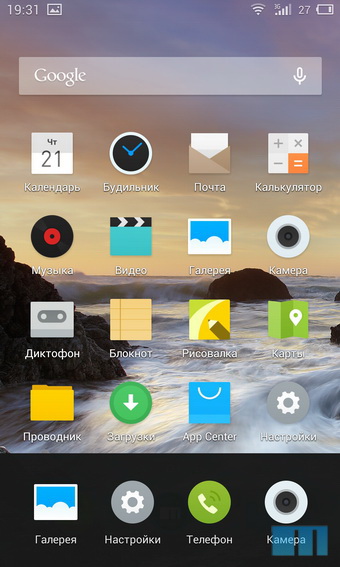
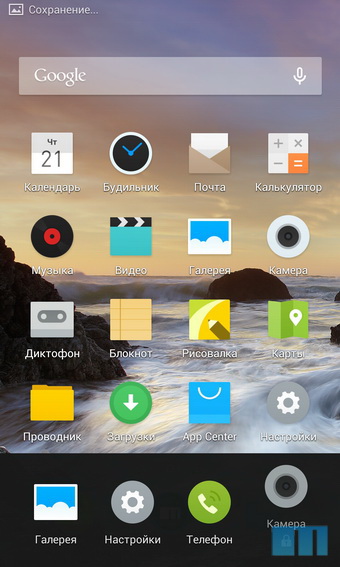
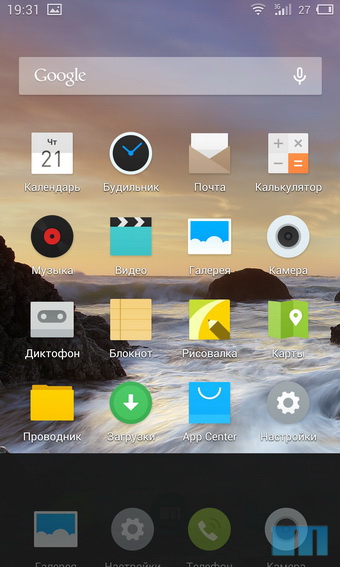

Most of the innovations are described in the section “Special features”.
After launching the application, three categories appear on the screen: all songs, folders and recently added ones. The album cover is located above, and the player control is below. Further compositions can be sorted by tracks, artists and albums. The bottom right is the settings (three points):
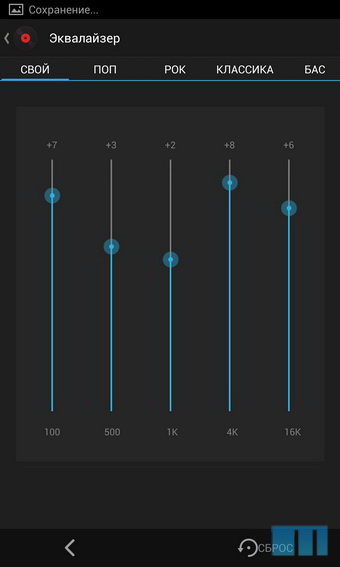

There are 4 presets and manual settings in the equalizer section. The equalizer bands 5 - from 100 Hz to 16 kHz. A separate Wolfson WM5102 chip is responsible for sound processing; there is Dirac HD technology. The sound quality is really amazing: the purest high and pleasant “warm” low frequencies. The smartphone understands the following audio formats: FLAC, APE, AAC, MKA, OGG, MP3, MIDI, M4A, AMR, WAV.


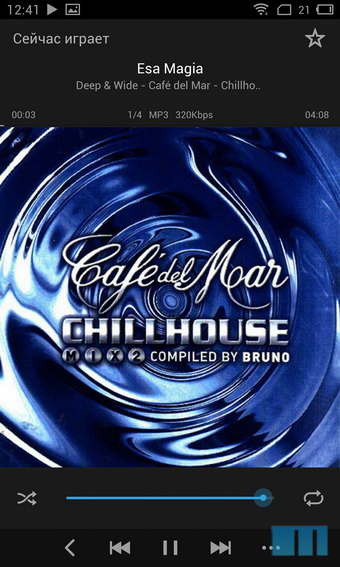
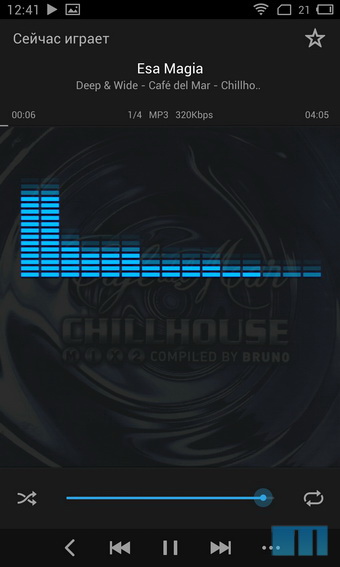

With a video player a little easier, but no less cool with features. Without any problems, it loses almost all video formats in any resolutions: MP4, 3GP, MOV, MKV, AVI, FLV, MPEG, M2TS, TS and many others.

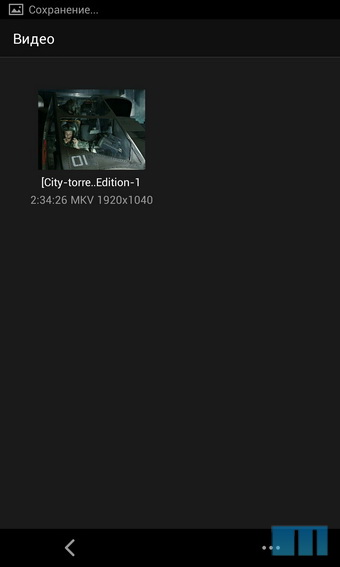

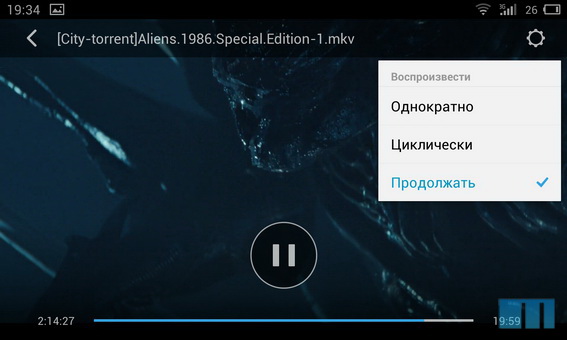
The Meizu MX3 has everything the user needs: a large screen diagonal, a simple, beautiful shell, high speed, no “brakes” and “glitches”, good autonomous work, as well as a slim and durable case. And, most importantly, the amazing sound in the headphones, which is noted by almost everyone who has tried to listen to music on the MX3 at least once.
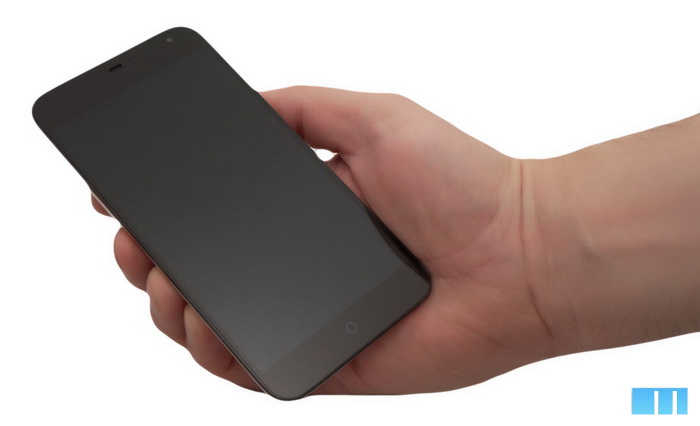

Positive points :
Negatives :
Strangely enough, but the same thing that happened in Meizu MX2: inconvenient to open the rear panel, the absence of a memory card slot and a slightly “noisy” camera, but the last moment, as shown by MX2, developers can successfully neutralize the release of new firmware, in which camera performance will be constantly improved.
Cost Meizu MX3:
Website Meizu Russia

Meizu MX3 Specifications
- Operating system : Android 4.2 with Flyme 3 shell
- Communication : GSM / GPRS / EDGE / 3G (WCDMA) / HSPA + 850/900/1800 MHz (2G), 850/2100 MHz (3G)
- Screen : Sharp New Mode 2, 5.1 ”diagonal, 1800x1080 pixels resolution, PPI 415, 1000: 1 contrast ratio, maximum brightness 450 cd / m, 2048 brightness gradations, TOL technology (single module - glass plus sensor), energy-saving PSR technology, protective glass Gorilla Glass 2
- Platform : Samsung Exynos 5410, 8-core processor (4 cores 1.6 GHz Cortex-A15 and 4 cores 1.2 GHz Cortex-A7), 28 nm process technology LP HKMG
- Graphic processor : PowerVR SGX 544MP3 (533 MHz, 3 cores).
- RAM : 2 GB, DDR3
- Memory for data storage : 16/32/64 GB
- Camera : 8 MP (Sony Exmor BSI-sensor, IMX179 CMOS chip, 1.4μm photosensitive element), shooting speed: 20 frames / sec; 5 lenses, F / 2.0 aperture, 74 ° angle, “instant filter” function, video recording 30 fps 1080p, panorama shooting, gyro focus, HDR function, face detection, gesture shot
- Front camera : 2Mp (Sony sensor), video recording 30 fps 1080p.
- Multimedia : Wolfson WM5102 sound chip, Dirac HD technology, Smart PA noise reduction acoustic system with three microphones, Fujitsu four-channel image processing chip
- Supported formats : FLAC, APE, AAC, MKA, OGG, MP3, MIDI, M4A, AMR, WAV, MP4, 3GP, MOV, MKV, AVI, FLV, MPEG, M2TS, TS, JPEG, PNG, GIF, BMP and many other
- Interfaces : Wi-Fi 802.11 b / g / n, 2.4GHz / 5GHz (max. Speed 150 Mbit / s), Bluetooth 4.0, microUSB (support USB-OTG), NFC (except MEIZU MX3 16GB), 3.5 mm for headphones and headsets
- Navigation : GPS / A-GPS / GLONASS, electronic compass
- Optional : touch sensor, light sensor, gravity sensor, electronic compass, gyroscope
- Battery : 2400 mAh, Sony, dual chip for power management
- Dimensions : 139.0 x 71.9 x 9.1 mm
')
Kit
The box is traditionally white in color, neatly made, the material is thick cardboard. On the front side is the “MX3” model. On the back of the following parameters: the weight of the device, the amount of memory, equipment and communication capabilities.


Inside the box you will find an original “book” with brief information about the device, a user manual, a small package with a USB cable and a plastic “clip” for opening the lid, a network adapter for the Russian standard. In general, the packaging is not much different from that for the Meizu MX2.
Appearance, design
Despite the similarities between the MX2 and MX3, the latter is still different from the flagship of the previous year. The first thing worth noting is the dimensions: in the last year's model, the thickness was 10.2 mm, while the novelty has 9.1 mm. It seems to be a small difference, but in the Meizu MX3, the side faces are beveled more strongly, so the impression is created (and the sensations, too) that the gadget is much thinner than the MX2. Just because of this, the smartphone is ideally in the hand. Another question is the increased size of the case (139x71x9.1mm versus 124x64x10.2), but there's nothing you can do, since the screen diagonal also increased from 4.4 to 5.1 inches.


Became thinner display frame. Now, to the right and to the left, they are only 2.9 mm, and from above and below - 14 mm. Looks very elegant. Since the front panel is black, in the off state of the screen the frames are not at all visible (if we are talking about a black smartphone) - one dark plane without any fancy elements.


The case is made in such a way that the side frame (by the way, it has become almost two times thinner than in MX2) almost does not heat up when the processor is under heavy load, since this is not a single metal plate, but a design with several elements. Vertical polishing is applied to the piping, this further emphasizes the "hardware" used in the manufacture of the phone.
Screenshots from the official website of Meizu:



The back panel is still removable, but under it you will find only a slot for a microSIM card and a battery. The lid is plastic, white (if you remember, in MX2 it is closer to the milk one), the surface is glossy. Unlike the Meizu MX2, here the lid does not have a “glazed” effect: the bottom layer is opaque, the top is glossy. Over time, small scratches will appear on the panel, just like on any other device that uses plastic. However, it is not scary - if the cover is worn out, you can always buy a new one of the same or a different color. The prints on the cover of course remain, but almost not noticeable. The screen has an oleophobic coating and traces of it are erased very easily.


If we talk about the assembly, it is perfect. Even strongly “used” non-commercial samples almost did not play or creaked. With commercial devices, everything is all the more good: there are no gaps, cracks or other defects, the lid is very securely fastened, and even if the smartphone falls, it most likely will not fly off.
On the front side of the smartphone at the top is a small slot where the speaker is located. Voice quality is excellent, the volume is high, there is no noise, no echo. They hear you too well: for several weeks no communication breaks, “croaking” and signal disappearing for short periods of time were noticed.

Just to the right of the speaker are two special sensors for tracking ambient light and locking the screen while holding the phone to your ear. Work properly. More to the right - an additional camera for video chats.
At the bottom is a small round touch button. Unlike the previous MX2, in MX3 it is more noticeable; if you want, it is highlighted more brightly. It performs, in principle, the same functions, but the gestures have slightly changed. For example, to unlock a smartphone, you need to slide your finger from the “roundel” to the screen, after unlocking in this way, you immediately get to the screen with program shortcuts, and not to the lock screen, as it was on MX2. In my opinion, very simple and fast. “Swipe” up - the action “back”, long holding the touch ring - lock the screen. In the active state, the button is lit in white, while skipping messages or other events flashes intermittently, and in standby mode it turns dim in dark green.


The volume key is located on the left side of the smartphone. Made from translucent white plastic. It is thin, but easily groped with fingers.

The microUSB connector is located on the bottom, next to the main microphone. Above - the usual 3.5 mm audio jack and power on / off button, as well as the screen lock / unlock.


Behind are the camera's peephole, covered with protective glass and framed with a metal frame, a small flash, a second microphone and a speaker. The speaker volume is quite high, standard ringtones are well chosen - many of them can be heard, even if you close the speaker hole.


To remove the cover Meizu MX3, you need a special tool, "mediator", included in the kit. Insert it into the hole located on the right lower edge of the smartphone, and gently pull the cover with your nails. From the first time, not everyone gets it, but if you do it without haste, there will be no problems.


Screen
In the first MX, the screen diagonal was 4 inches, in the second - 4.4, and in the third the screen “grew” to 5.1 inches. The resolution also became more and more: 540x960, 800x1280, in the new product it is 1080x1800 pixels. The density in pixels is 415 (pixels on the display, even with good will, you will not see, unless, of course, you resort to a magnifying glass or microscope), according to the measured manufacturer’s data, the contrast is 1000: 1, the maximum brightness is 450 cd / m, gray gradations are 2048. Matrix display Meizu MX3 (as well as the MX2) is made by technology Sharp New Mode 2 - analog Sharp IGZO. When compared to IPS-LCD, then the MX3 matrix has more viewing angles, and the colors are not distorted under any inclination of the screen. It gives pleasant juicy colors, let's say, almost natural. There is no air gap between the matrix and the protective glass of Gorilla Glass 2 - TOL technology. In addition, developers are talking about energy-saving technology PRS - (PanelSelf-Refresh), it allows you to spend less energy to display data on the screen.
The touch layer is made by capacitive technology and handles up to 10 simultaneous touches. Brightness has a very large control range. The minimum brightness is sufficient for comfortable reading of books at night, and on a sunny day it can be done higher, well, or trust the automation. In the sun, the screen remains well read.
Settings:



Screen:








Performance and Memory
The Meizu MX3 uses one of the newest platforms from Samsung - the Exynos 5410: an 8-core processor (4-core 1.6 GHz Cortex-A15 and 4-core 1.2 GHz Cortex-A7), 28-nm LP process HKMG. The architecture of the Cortex-A15 and the modern 28nm LP LP HKMG technological process increase the computational power of the model by 1.8 times compared with the previous generation.
The graphic part is a PowerVR SGX544 MP3 chip (533MHz, 3-cores), it renders at a speed of 280 million triangles per second and can effectively fill 7.9 billion pixels, which is equivalent to updating the high-resolution screen 1270 times per second. The performance of the new GPU has increased by 267% compared with the previous generation.
RAM in the device 2 GB (dual-channel third-generation DDR3). This allowed us to provide data throughput at speeds of up to 12.8 GB / s. Free from this volume is about 1.2 GB.

Built-in memory 16/32/64 GB. The 128 GB model was originally planned, including in the international version, but so far the company does not provide information on when it will appear. The system and the basic applications employ about 3 GB, that is, in 16 GB models, approximately 13 GB are free, in 32 - 29 GB, and so on.

The following are the most popular synthetic system performance tests:





Navigation and Interfaces
As with any Android smartphone, there is a Google Maps application for GPS or GLONASS navigation. Testing in the GPS test program showed that a cold start takes about 2 minutes, and a hot start takes just less than 7-10 seconds. If you turn on A-GPS and mobile Internet, the wait can be reduced to 5 seconds.
Meizu MX3 works in networks GSM / GPRS / EDGE / 3G (WCDMA) / HSPA + 850/900/1800 MHz (2G), 850/2100 MHz (3G), there is support for Wi-Fi 802.11 b / g / n, 2.4GHz / 5GHz (max speed 150 Mbit / s) and Bluetooth version 4.0. In place of USB 2.0, to which you can connect, for example, a data storage device (USB flash drive), since the phone supports USB Host. In models with 32 GB of memory and above, there is an NFC chip.




For more convenient switching of network modes, Flyme has built-in switches, they are located at the top right in the "notification panel".
Photo and video camera
Despite the general trend of expanding megapixels in the cameras of mobile devices, Meizu did not, roughly speaking, show off, so in the MX3 model we have an 8 megapixel main camera module and 2 megapixels frontal. However, the main camera sensor is a Sony Exmor BSI module (IMX179 CMOS chip, 1.4μm photosensitive element), and the aperture is F2.0!

The quality of the photos is not bad, but the developers still have to work on the camera, since there is still a lot of noise. This should not worry the users, since the situation was about the same with MX2 immediately after the launch: after a small amount of time, the firmware was introduced, which “fixed” all the “bugs” of the camera (sorry for the slang). If we talk about the pros, it is worth highlighting the excellent white balance, fast autofocus, zero delay, high shooting speed (up to 20 fps) and super macro from 2 cm. Rollers MX3 writes in FullHD resolution 30 fps, autofocus is induced when touched screen.
Photo mode :
- Shooting mode: auto, panorama, macro, text, portrait
- ISO: Auto, 50, 200, 400, 800
- White balance: auto, fluorescent, outdoor, incandescent
- Shooting settings: location, filters, gesture shooting, photo size (1 MP, 3 MP, 5 MP and 8 MP)
- Record settings: 480p, 720p, 1080p
To display the HDR settings and exposure, click on the screen twice.








Gallery:









Below are examples of photos:



























Front-camera:

- Sample video in sunny weather
- Sample video in the evening
- Sample video in the subway
- Sample video at night
Autonomous work
The device was equipped with a built-in lithium-ion (Li-Ion) battery, the capacity of which is 2400 mAh. Model - Sony M351. After thorough testing, I cite a little more correct data. In parentheses indicate official data.
- Talk time (auto switch between 2G / 3G) - 10 (14) hours
- In the mode of Wi-Fi-surfing - 9 (10) hours
- In 3G surfing mode - 7 hours
- In the video viewing mode (720p, the maximum brightness of the screen backlight) - a little more than 6 (7) hours
- In the mode of playing music - more than 45 (40) hours
- In standby mode, the phone can lie for 17 days (429 hours according to official data).
By default, the battery statistics in Flyme 3 is hidden in the Meizu MX3 settings. In order for it to appear, you need to enter * # * # 6961 # * # * in the "dialer" of the phone (after entering the code, go to Settings - Accessibility - Battery).




To get additional information about the device (battery status, heat, usage statistics, information about Wi-Fi and the phone itself), you need to enter the combination * # * # 4636 # * # * in the dialer.
Innovations Flyme 3
Meizu MX3 works on the Android 4.2.1 Jelly Bean operating system with the proprietary UI Flyme 3 (latest update at the time of the review). In the coming days we will prepare a detailed overview of the shell, so in this text I will focus only on the main points.

Icons . They have become flatter, but for those who love volume and color, there are alternative themes with colorful icons.


Settings . Now, having entered the settings, you can see the icons on the left, and the parameters that correspond to the section on the right. “Swipe” to the left to the right of the icon opens the description of the section.


Animation . It became smoother, noticeably, as when launching applications it flies out from the center of the screen and flies away to the center when it leaves it.
List of applications . Now labels can be ordered not only on separate desktops on the right or on the left, but also to place icons under the main desktops. To do this, drag any icon under the lowest icon.

Panel with running programs . It is necessary to hold your finger from the bottom edge of the screen up. To unload all applications from the device’s memory, “swipe” to the icon down, to close a specific “program” - “swipe” up. If you run your finger along the panel from right to left, a brightness control scale will appear and slots for assigning quick launch applications (up to 5 pieces).




Most of the innovations are described in the section “Special features”.
Music and video
After launching the application, three categories appear on the screen: all songs, folders and recently added ones. The album cover is located above, and the player control is below. Further compositions can be sorted by tracks, artists and albums. The bottom right is the settings (three points):
- Editing information
- Equalizer
- Set timer


There are 4 presets and manual settings in the equalizer section. The equalizer bands 5 - from 100 Hz to 16 kHz. A separate Wolfson WM5102 chip is responsible for sound processing; there is Dirac HD technology. The sound quality is really amazing: the purest high and pleasant “warm” low frequencies. The smartphone understands the following audio formats: FLAC, APE, AAC, MKA, OGG, MP3, MIDI, M4A, AMR, WAV.





With a video player a little easier, but no less cool with features. Without any problems, it loses almost all video formats in any resolutions: MP4, 3GP, MOV, MKV, AVI, FLV, MPEG, M2TS, TS and many others.




Conclusion
The Meizu MX3 has everything the user needs: a large screen diagonal, a simple, beautiful shell, high speed, no “brakes” and “glitches”, good autonomous work, as well as a slim and durable case. And, most importantly, the amazing sound in the headphones, which is noted by almost everyone who has tried to listen to music on the MX3 at least once.


Positive points :
- Robust housing with metal trim
- Good speed work
- One of the best displays among the flagships
- Loud and very high-quality sound in headphones
- Beautiful and simple flyme shell
Negatives :
Strangely enough, but the same thing that happened in Meizu MX2: inconvenient to open the rear panel, the absence of a memory card slot and a slightly “noisy” camera, but the last moment, as shown by MX2, developers can successfully neutralize the release of new firmware, in which camera performance will be constantly improved.
Cost Meizu MX3:
- Meizu MX3 16 GB - 17 990 rubles
- Meizu MX3 32 GB - 19 990 rubles
- Meizu MX3 64 GB - 21 990 rubles
Website Meizu Russia
Source: https://habr.com/ru/post/203792/
All Articles